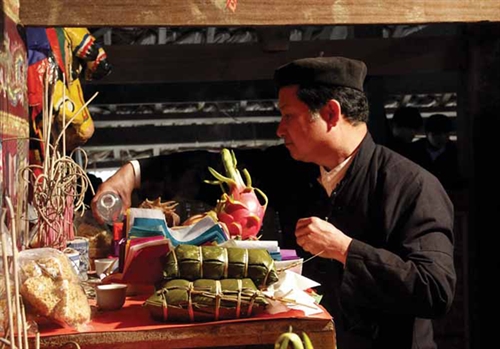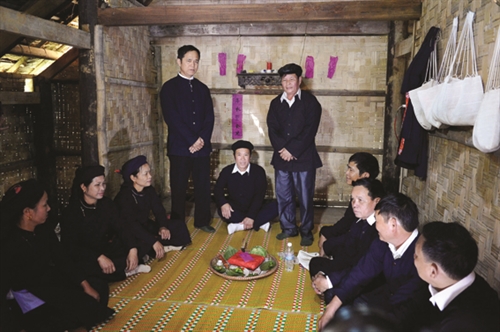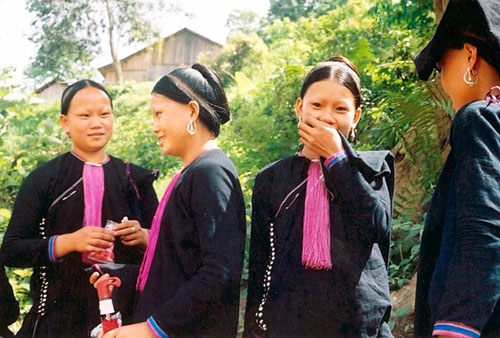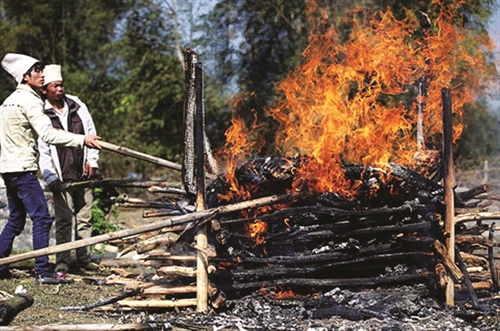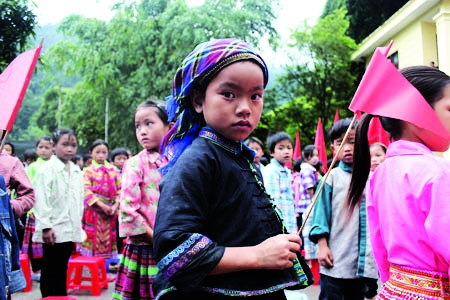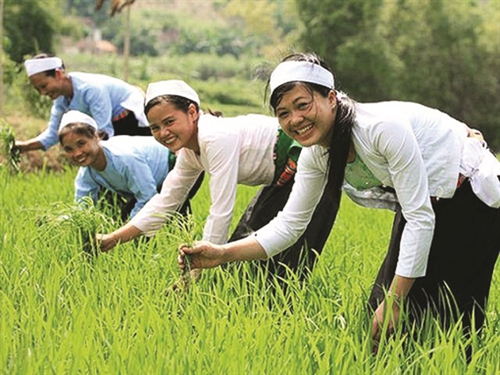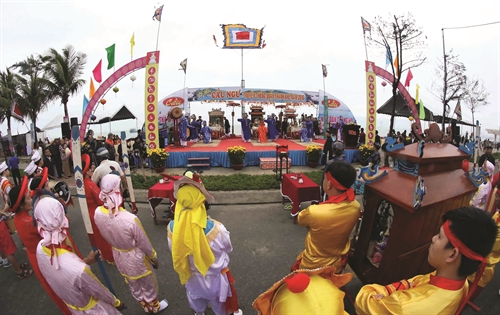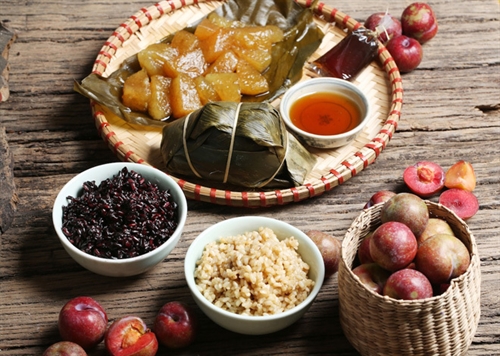>>The Ha Nhi: Customs, practices and folk laws
Ta Thi Tam
Ethnology Institute
The Ha Nhi, a Tibetan-Burmese language ethnic group living in the northern provinces of Lao Cai, Lai Chau and Dien Bien, show special respect for their ancestors who symbolize sacredness and goodness. The group reveres their ancestors to express their gratitude for the ancestors’ giving birth to and bringing them up as well as to pray for their blessing. Ancestor veneration features a beautiful cultural trait of the Ha Nhi.
Beliefs and rituals of ancestor worship
The Ha Nhi believe after a person dies, his spirit can still return home to protect his family members. That’s why, when burying the deceased, the Ha Nhi arrange stones into a small gate on his grave through which the spirit will return home.
As the Ha Nhi do not practice disinterment, they choose grave sites carefully to avoid relocation. Three years after the funeral of a person, family members visit and clean up his grave, and prepare offerings for an outdoor ceremony to escort his spirit back home for veneration. They sacrifice a pig or chicken and cook offerings for the deceased right at his grave. All families in the village are invited to this ceremony marking the end of the family’s mourning period after which the family is allowed to join the community’s common rituals. Also after this ceremony, the family can venerate the deceased on the altar in their house without having to bring offerings to his grave.
The altar in a Ha Nhi house is a small wooden table around 40 cm high placed in the middle of the house next to the main pillar, believed to be the shelter for the ancestors. It is also close to the stove which accommodates a stone, the symbol of the kitchen god who is believed to take care of the family. The house’s part with the altar is regarded to be the most sacred place where women are not supposed to lie, sit or pass by.
When a man gets married and moves away from his parents, he can set up an ancestor altar at his own home as the Ha Nhi venerate generations of family line rather than just grandparents and parents as practiced by many other ethnic minority groups.
Ha Nhi people have certain rules in ancestor veneration. First, all the food offered to ancestors must be prepared by the wife of the family or, if she is ill or has passed away, by her oldest daughter-in-law. A family that does not have a daughter-in-law yet will have its oldest daughter to cook the food even when she has got married.
Second, if the offerings are made by the wife, the husband chairs the rituals.
Next, in an ancestor reverence ritual, the family host and other members must wear Ha Nhi traditional costumes but go bare feet. To pray in front of the altar, the family host falls to his knees and bows his head till his forehead touches his palms put on the ground. After he repeats this act three times, other family members follow suit, but only once. The Ha Nhi do not speak out prayers but keep them in mind, which include invitations for ancestors to return home and enjoy the offerings, and pleas for their protection of the family.
Finally, after a ritual, the offerings must be shared with the god kitchen (the stone placed in the stove) and all family members.
When a family is observing a ritual dedicated to ancestors, strangers are not supposed to enter their house as the offerings are exclusively made for the deceased, not for outsiders. Family members are believed to be punished by their ancestors if letting a stranger interrupt the ritual. That’s why, the family must hang a green tree branch at the entrance as a signal warning uninvited visitors.
 |
| A Ha Nhi woman in Muong Te district, Lai Chau province, prepares ancestral altar offerings__Photo: Quang Duy/VNA |
Ceremonies dedicated to ancestors
The Ha Nhi do not venerate their ancestors in their death anniversaries as practiced by most ethnic groups, but in community ceremonies, including the lunar new year festival, or when the family has an important event such as wedding, funeral or illness of a family member.
In the lunar new year festival, their most important ceremony, the Ha Nhi carefully prepare offerings for their ancestors to show gratitude for their protection in the past year and ask for their support in the new year. Weeks before the lunar new year, every Ha Nhi family stocks rice, poultry, vegetables, rice wine and firewood as materials for making the offerings. Each family also cleans up and decorates its home to get rid of all misfortunes and ring in the new year. Early morning of the lunar new year’s Eve, women cook sticky rice and make banh day (round sticky rice cake) for their ancestors to eat on their way home from heaven. In the afternoon, all family members have a bath using water boiled with scented herbs to wash off dust before joining the ancestor veneration.
An important formality for every Ha Nhi family before observing the offering ritual to their ancestors is to take sacred water home. The Ha Nhi believe taking water in the first moments of the new year will bring in good health for all family members as water is bestowed by gods at this particular time. Water must be taken by women as they take charge of kitchen chores in the family. Right in the Lunar New Year’s Eve, women quietly bring bamboo water containers to the village’s water source, where they burn incense to ask for the water god’s permission to take water home in hopes of starting a new year with best luck. The taken water will be used to cook the food offered to ancestors on the first day of the new year. The offerings include banh day, chicken, ginger water, liquor and farm produce gained in the previous year such as soybean, pumpkin, corn and melon. In this ceremony, the family host invites their ancestors home to celebrate the new year and prays for their support for a year of peace, prosperity and best luck.
When there is a community ceremony, every Ha Nhi family makes offerings to their ancestors to invite them to such event. One of these events is kho gia gia ceremony held in the sixth lunar month to win gods’ support for the whole village. Apart from contributing offerings for the community ritual held in the village forest, every family prepares a tray of offerings for their ancestors and the kitchen god. The offerings include five banh days, a bowl of buffalo meat the family is shared from the sacrificed buffalo in the community ritual, a bowl of liquor and a bowl of ginger water. Completing the praying formality, the family host leaves some buffalo meat and banh day on the stone (the kitchen god), pours the ginger water onto the stove, puts some food at the entrance door for the ancestors’ servants, and shares the remaining offerings to all family members.
In the seventh lunar month, the Ha Nhi hold kho le le ceremony to drive away evil spirits to bring peace to the village. In this ceremony, the Ha Nhi clean up their homes and make banh day for offering to their ancestors in a ritual conducted in the morning of a date of the horse, the sacred animal for the Ha Nhi, asking for the ancestors’ protection of the family against evil spirits. The ritual to chase away evil spirits is carried out at nightfall in which a man of the family, with a sickle and a piece of charcoal taken from the family’s stove in one hand and a branch of mugwort and a branch of raspberry in the other hand, runs around the home, treading against the walls, waving the sickle above and repeatedly saying “get out of here, evil spirits.” He then runs out of the house to chase evil spirits out of the village. After that, he leaves the charcoal and the branch of mugwort outside the village and hangs the sickle and the branch of raspberry at the entrance gate of his house, which are believed to guard evil spirits from entering the house. When driving away evil spirits from the village, villagers are supposed to run as fast as possible which is believed to increase strength to fight against evil spirits.
Ha Nhi ancestors are also remembered in the harvesting ceremony held in the eleventh month after harvesting time. This ceremony gives the family a chance to express thanks for their ancestors’ support for crops. Offerings are chicken or pork, banh day, two bowls of ordinary rice and sticky rice, a bowl of ginger water and liquor. After this ceremony, family members do not work for three days, staying at home and sharing farming experiences for a better crop next year.
The Ha Nhi also rely on protection from their ancestors for good health and longevity of their members. When a person suffers a serious illness or an elderly person grows weaker, his family holds a ceremony to pray for long life for him on his birth date. The ceremonial offerings include chicken, pork, sticky rice, liquor and ginger water which will be first offered to the forest god in a ritual conducted by the village shaman in the village’s sacred forest. In this ritual, the shaman asks for the forest god’s permission for the family to hold the pray-for-longevity ceremony at home. After that, the offerings are brought home for offering to the family’s ancestors. This ceremony is attended by relatives who each bring some rice for the person asking for long life. It is believed that the more guests attend the ceremony (i.e. the more rice the family will receive) a longer life the person concerned will live. After the ceremony finishes, the family invites the guests to a feast.-
